So that the heating system does not refuse to the most busy moment, the heating season passed without problems, it is necessary to periodically check the condition of the equipment, to identify all worn items. Such an inspection is called "Pressing the heating system", it is carried out according to certain rules.
What is the crimping system of heating and water supply
Heating and water supply are two systems consisting of a large number of the most diverse equipment. As is known, the performance of any multicomponent system is determined by the weakest element - when it fails, it stops completely or partially. To reveal all weaknesses and crimping heating and water supply. If we speak in simple language, the pressure is specially raised much higher than the worker, pumping the liquid. Do it with special equipment, control pressure with a pressure gauge. The second name of therapy is hydraulic tests. Probably clear why.
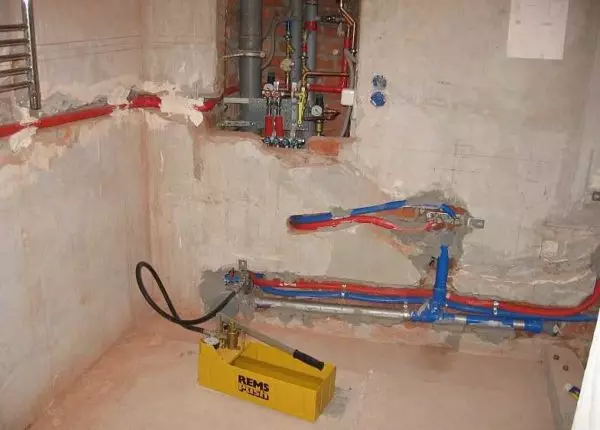
Pressing heating is carried out after any repairs or before the heating season
When the heating system is pressed, the pressure is raised by 25-80% depending on the type of pipes, radiators, other equipment. It is clear that such a test identifies all weak points - everything that does not have the stock of strength, breaks, in worn pipes and unreliable connections appear leaks. By eliminating all identified problems, ensure the efficiency of your heating or water supply for a while.
If we are talking about centralized heating, then crimping usually is carried out immediately after the end of the season. In this case, there is a decent time interval for repair. But this is not the only case when such events are held. Pressing still passes after repair, replace any element. In principle, this is understandable - it is necessary to check how reliably new equipment and connections. For example, you sailed from polypropylene pipes heating. It is necessary to check how high-quality compounds turned out. This can be done with the help of crimping.
If we talk about autonomous systems in private houses or apartments, then a new or repaired water supply is usually checked simply starting the water, although it does not interfere with the test. But the heating is desirable to experience "on complete", and before commissioning, and after repair. Keep in mind that those pipelines that are hiding into the walls in the floor or under the suspension ceiling must be tested until they close them. Otherwise, if when testing it turns out that there are leaks there, you will have to disassemble / break and troubleshoot problems. Few this will make it.
Test equipment and frequency
Pressing centralized systems is carried out by staff using staff, therefore it is hardly worth talking about it. But what is experiencing private heating and water supply, probably not everyone knows. These are special pumps. There are two types - manual and electrical (automatic). Manual crimping pumps Autonomous, pressure is injected using a lever, control the pressure on the integrated pressure gauge. Such pumps can be used for small systems - it is quite difficult to download.
Article on the topic: We select wallpapers in the corridor: design, photo and 3 rules
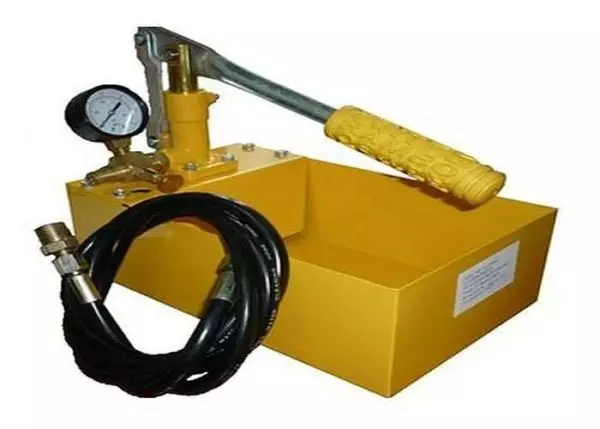
Manual crimping machine
Electric pumps for crimping - more complex and expensive equipment. They usually laid the opportunity to create a certain pressure. It is set by the operator, and "catches it" automatically. Such equipment is buying firms engaged in crimping professionally.
According to SNOP, the hydraulic test of heating systems should be carried out annually, before the start of the heating season. This also applies to private homes, too, but few people do this norm. Check at best times in 5-7 years. If you are not going to test your heating every year, then there is no point in buying therapy apparatus. The cheapest manual is about $ 150, but good - from $ 250. In principle, it is possible to take it for hire (usually there are in firms selling components for heating systems or in desks for hire vehicle). The amount will be released small - you need a device for several hours. So this is a good output.
Call specials or do it yourself
If you are required for some purpose an act of crimping the heating system or hot water supply, you have only one way out - to order this service in a specialized organization. The cost of recressing heating can only be voiced individually. It depends on the volume of the system, its structure, the presence of shut-off cranes and their status. In general, the cost is considered based on the tariff for 1 hour of work, and it fluctuates from 1000 rubles per hour to 2500 rubles / hour. We will have to call different organizations and cope with them.
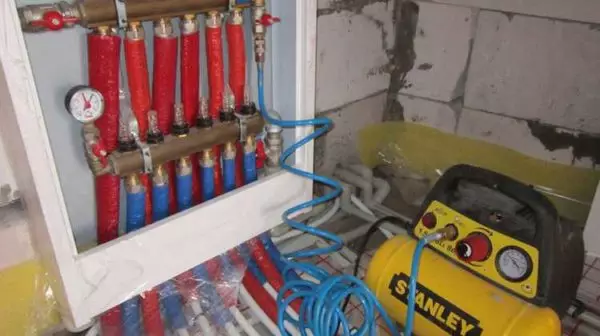
Firms involved in hydraulic checks of systems, equipment more serious
If you upgraded the heating or hot water supply of your own home, and you know exactly what pipes and equipment are in normal condition, there are no salts and deposits in them, you can conduct crimping yourself. No one demands acts of conducting hydraulic tests. Even if you saw that the pipes and radiators are clogged, you can rinse everything yourself, after which it is again tested. If you just do not want to do this, you can call specialists. They immediately and make the system and will hold her crimping, and they will give you an act.
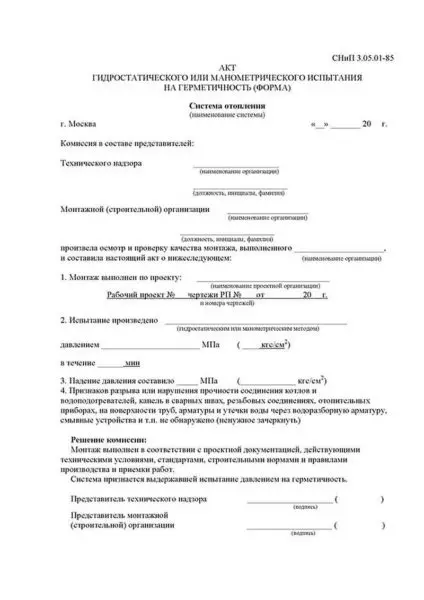
Act of hydrostatic testing system (crimping)
Process crimping
The crimping of the heating systems of the private house begins with a disconnection from the heating boiler system, automatic air vent and expansion tank. If there are locking cranes on this equipment, it is possible to close them, but if the cranes are faulty, the expansion tank will definitely fail, and the boiler - depending on the pressure that gives it. Therefore, the expansion tank is better to remove, especially since it is easy to do it, but in the case of the boiler will have to hope for the health of the cranes. If there are thermostators on radiators, they are also desirable to remove - they are not designed for high pressure.
Article on the topic: Mansard insulation by foam - dangerous!
Sometimes not all heating is tested, but only some part. If possible, it is cut off with the help of shut-off reinforcement or set temporary jumpers - Signs.
There are two important points: Pressing can be carried out at an air temperature not lower than + 5 ° C, the system is filled with water with a temperature not higher than + 45 ° C.
Next, the process is:
- If the system was in operation, the coolant merges.
- Crusher is connected to the system. From him, there is a hose ending with a cape nut. This hose is connected to the system in any suitable place, at least at the place of the removed expansion tank or instead of a drain crane.
- Water is poured into the capacitance of therapy pump, with the help of the pump it is pumped into the system.
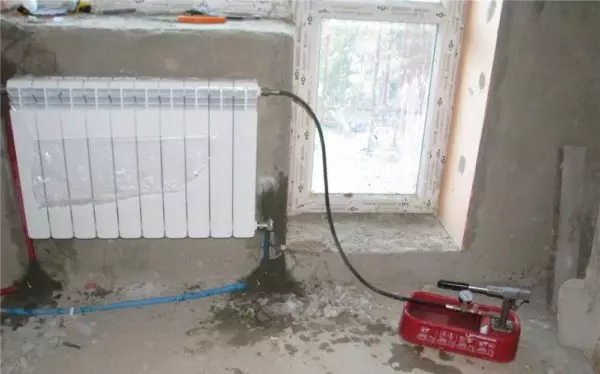
The device connects to any accessible input - on the serving or reverse pipeline - it does not matter
- Before lifting pressure, you must remove all air from the system. To do this, it is possible to pump a slightly system with an open drain crane or pull it through the aircraft on the radiators (Maevsky's cranes).
- The system is communicated to the operating pressure, it is withstanding at least 10 minutes. During this time, all the remaining air descends.
- The pressure rises to the verification, it is withstanding a certain period of time (regulated by the standards of the Ministry of Energy). During the test, all devices and connections are checked. They are examined, for the appearance of leaks. And even a slightly humid compound is considered to be a bit (fogging also requires elimination).
- During crimping, the pressure level is controlled. If during the test, its fall does not exceed the norm (spelled out in SNIVA), the system is considered good. If the pressure fell at least a little lower than the norm, you need to look for a leak, eliminate it, then start the crimping again.
As already mentioned, the crimping pressure depends on the type of equipment test and system (heating or hot water supply). Recommendations of the Ministry of Energy, set out in the "Rules for the technical operation of thermal power plants" (p. 9.2.13) for ease of use are reduced to the table.
| Type of equipment testing | Test Pressure | Test duration | Permitted pressure drop |
|---|---|---|---|
| Elevator knots, water heaters | 1 MPa (10 kgf / cm2) | 5 minutes | 0.02 MPa (0.2 kgf / cm2) |
| Cast iron radiators systems | 0.6 MPa (6 kgf / cm2) | 5 minutes | 0.02 MPa (0.2 kgf / cm2) |
| Systems with panel and convectable radiators | 1 MPa (10 kgf / cm2) | 15 minutes | 0.01 MPa (0.1 kgf / cm2) |
| Hot water pipe systems made of metal pipes | Operating pressure + 0.5 MPa (5 kgf / cm2), but not more than 1 MPa (10 kgf / cm2) | 10 minutes | 0.05 MPa (0.5 kgf / cm2) |
| Hot water supply systems from plastic pipes | Operating pressure + 0.5 MPa (5 kgf / cm2), but not more than 1 MPa (10 kgf / cm2) | 30 minutes | 0.06 MPa (0.6 kgf / cm2), with further testing for 2 hours and a maximum drop of 0.02 MPa (0.2 kgf / cm2) |
Please note that for testing heating and water pipes from plastic pipes, time pressure excerpts for 30 minutes. If during this time no deviations are detected, the system is considered successfully past crimping. But the test continues for another 2 hours. And during this time, the drop in the system in the system should not exceed the norm - 0.02 MPa (0.2 kgf / cm2).

Compliance table of different pressure measurement units
On the other hand, in SNIP 3.05.01-85 (P 4.6) there are other recommendations:
- Tests of heating and water supply systems are 1.5 from the worker, but not lower than 0.2 MPa (2 kgf / cm2).
- The system is considered properly if after 5 minutes the pressure drop will not exceed 0.02 MPa (0.2 kgf / cm).
What provisions to use is an interesting question. While both documents and certainty there are no certainty, so it is eligible both. It is necessary to approach each case individually, given the maximum pressure on which its elements are calculated. So the working pressure of pig-iron radiators is not more than 6 atm, respectively, the test pressure will be 9-10 atm. It is also worth determined by all other components.
Pressing air
Not everywhere and does not always have the opportunity to rent an crimsher, how to buy it. For example, you need to test heating at the cottage. The equipment is specific and chances that familiar is very small. In this case, the crimping system of heating is performed by air. For its injection, you can use any compressor, even automotive. By pressure, the connected pressure gauge is followed.
Such crimping is less convenient and not entirely correct. Heating and water supply are calculated on the transportation of liquids, and they are much denser. Where water will not even feel, the air will be released. Therefore, with a lot of confidence, it can be said that air leakage will be - somewhere, there will be a loose connection. Moreover, to determine the place of leakage with such testing is difficult. Used for this soap solution, which are missing all the joints and connections, all places where the air can exit. Bubbles appear in the leakage site. Sometimes to look for a long time. That is why such crimping the heating system is not very popular.
Covering a warm floor has its own characteristics - you must first check the comb and all the instruments fixed on it. To do this, close all the loops feed valves and the loops, filling only a heat collector, check it up pressure. Having dropped it to normal, in turn fill the loop of the warm floor, and only then an overpressure is created. The process is described in more detail in the video.
Article on the topic: Installation instructions for wooden plinths
